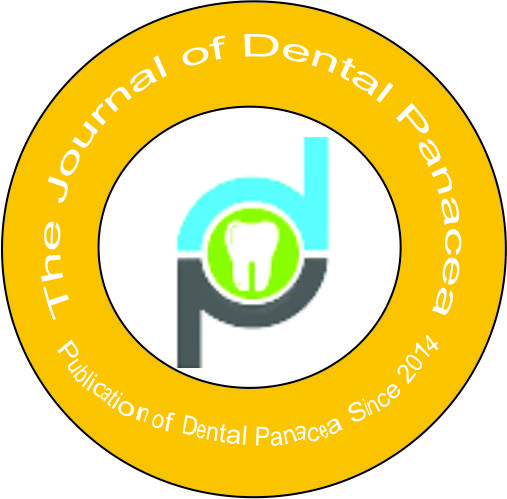- Visibility 53 Views
- Downloads 7 Downloads
- DOI 10.18231/j.jdp.2024.007
-
CrossMark
- Citation
Simplifying digital planning with clear aligners: A review
Introduction
In the past decade, the prevalence of orthodontic clear aligners as an alternative to traditional braces has surged due to more affordable production and material advancements. The expiration of various clear aligner patents in 2017 has led to a proliferation of new varieties in the market, posing challenges in assessing their performance since standardized measures are lacking. Existing literature on orthodontic clear aligners predominantly emphasizes qualitative aspects like optical clarity, stain resistance, and patient comfort.
There's a noticeable shift in the clinical field, with a move away from traditional braces to innovative technologies like clear aligners.[1] Before 1998, orthodontic clear aligners were primarily used for minor tooth adjustments, typically at the end of treatment or for minor alignment relapse. Clear aligners leverage computerized 3D technology to visualize and virtually move teeth, benefiting from advances in 3D printing and efficient manufacturing. These aligners, created through CAD-CAM (Computer-aided design and Computer-aided manufacturing) techniques, consist of transparent, thin (less than 1 mm) plastic material, similar to splints covering of clinical crowns and marginal gingiva. Each aligner aims to shift teeth by approximately 0.25–0.3 mm over a 2-week period and must be worn in a specific sequence, requiring strict compliance of at least 20–22 hours a day.[2]
Selection Criteria
Fully emerged permanent teeth.
Treatment suitability for individuals with minimal or no impact from growth, typically late adolescents and adults, addressing mild (1–3 mm) or moderate (4–6 mm) spacing and crowding.
Dental-origin narrow arches (4–6 mm).
Effectiveness in treating cases with relapse orthodontic movements.
Applicability for tooth movement post interproximal reduction.
Addressing issues such as flaring, distalization, and space closure following the extraction of a lower incisor.
Some malocclusions present greater treatment challenges, including [3]
Crowding and spacing exceeding 5 mm.
Discrepancies between centric relation and centric occlusion.
Severe rotation of teeth, surpassing 20 degrees.
Open bites, both anterior and posterior.
Extrusion of teeth.
Teeth with significant tipping, exceeding 45 degrees.
Short clinical crowns of teeth.
Arches with multiple missing teeth.
Closure of spaces resulting from bicuspid extractions.
Advantages [4]
The ability to remove trays for brushing, flossing, and eating, unlike traditional braces.
Clear, aesthetically pleasing, and comfortable trays without metal brackets or wires, reducing the risk of mouth irritation.
Enhanced oral hygiene compared to fixed options, allowing teeth bleaching during treatment.
Shorter appointments and reduced time for both the doctor and auxiliary.
Limitations [5]
A key limitation is compliance since the aligners are removable, relying on the patient's commitment and reliability for achieving desired results.
Treatment using this appliance requires all permanent teeth to be fully erupted.
The current system lacks the ability to incorporate basal orthopaedic changes.
Major restorative work must be completed before treatment begins, as changes to the teeth's surface anatomy during treatment can impact aligner fit.
Operator control is limited.
The system cannot seamlessly integrate the hard and soft tissues of the head into computerized treatment, leaving the clinician without direct indications of tooth positioning in relation to basal bone or soft tissues.
Impression Technique and Digitization
Treatment success hinges on obtaining a precise impression, achieved through either polyvinyl siloxane (PVS) or intraoral scanners. Initially, align technology employed a method known as destructive scanning to generate a three-dimensional (3D) digital image of the patient's teeth. This involved creating conventional 3D models by pouring impressions with plaster. These models underwent a destructive scanning process, where they were photographed from the occlusal view, milled down incrementally, and photographed again, until a series of digital photographs were used to digitally reconstruct the model. Despite the advantage of allowing lab technicians to address minor imperfections before scanning, this technique was costly, time-consuming, and generated substantial amounts of plaster dust.
Align technology has since abandoned, the destructive scanning approach and now directly converts impressions into 3D virtual models using high-resolution industrial computed tomography (CT) scans.[6]
Records — Submission
The impression, bite registration, radiographs, photographs and treatment plan are then sent to the manufacturer.[7]
The Virtual Setup
Upon arrival at the manufacturing office, the impressions undergo scanning via an industrial CT scan, generating a 3D virtual model ([Figure 1]). Utilizing wear facets, virtual contacts, and intraoral photographs, the technician employs the best-fit occlusion to articulate the models. It is crucial to note that the occlusal registration accompanying the impressions serves to validate the occlusion.
Following the creation of virtual models, boundary recognition software is employed to segment and define individual teeth ([Figure 2]). It is worth noting that the interproximal surfaces of teeth are generally not captured in the impressions. Hence, the software must interpolate this information and estimate the location of interproximal surfaces and contact areas. Once achieved, virtual roots are strategically placed. [8], [9]


With the preparation work concluded, the electronic transmission of the virtual model occurs, sending it to the manufacturing office or the designated software-operating facility. This facility utilizes a sophisticated 3D graphics program, providing the operator extensive control over tooth position and the rate of tooth movement.
Upon completion and approval of the virtual setup by the orthodontist, a series of plastic models is crafted through stereolithography. Subsequently, the aligners are produced via a thermoforming process on these models.
Software
The effective utilization of aligners for orthodontic correction depends on specialized software that digitally reconfigures teeth to ensure aesthetic improvement. [10] This software is operated by a technician or a doctor who formulates a treatment plan based on a provided prescription. For each tooth, the software calculates individual parameters and the speed of movement, taking into account factors such as crown shape, root size, and position in the arch.
Different aligner brands have patented unique software solutions. For example, Invisalign uses ClinCheck, Nuvola aligner employs NUVOLA CAD 3D software, and SureSmile relies on Orascanner 2 software. AIRNIVOL aligner utilizes the 3D AirCheck viewer, while 3M™ Clarity™ utilizes analysis and treatment planning tools within the 3M™ Oral Care Portal. Intelligent alignment systems adopts the digital process developed by Don ([Figure 3]) for the Inman aligner in both Clear Smile aligners and Clear Smile braces.

Fabrication of Appliances
The first step involves creating impressions, which are poured up in dental plaster and encased in epoxy and urethane within a tray. Subsequently, these tray-encased models undergo a scanning process, where a rotating blade on a destructive scanner meticulously removes thin layers, and a computer linked to the scanner compiles the scanned data to generate a 3-dimensional representation of the models.[11]
After establishing the bite, a virtual orthodontic technician (VOT) utilizes software to virtually "cut" the models, separating the teeth for individual manipulation. A virtual gingiva is then positioned along the gingival line of the clinical crown, serving as a margin for aligner manufacturing. The orthodontist's prescription guides the virtual alignment of teeth and bite using the company's software ([Figure 4]).
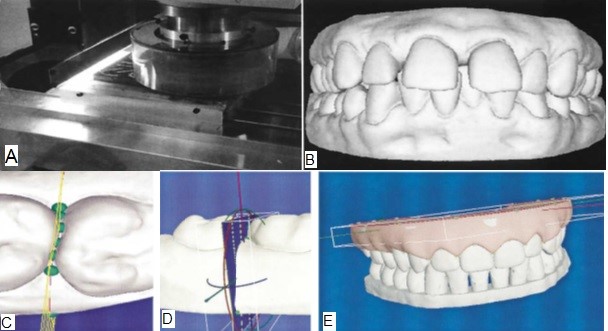
Once the final setup is complete, tooth movements are staged to eliminate occlusal and interproximal interferences, adhering to the company's predefined criteria for movement velocity. The VOT can transmit the data to the referring orthodontist for review on the respective website.
Upon the orthodontist's approval of the treatment plan, the aligners are manufactured to replicate the computer-screened movements clinically. Computer images are converted into physical models through stereolithography. These models are then utilized in the fabrication of aligners using a Biostar pressure moulding machine (Great Lakes Orthodontic Products, Tonawanda, NY) ([Figure 5]). The aligners undergo trimming and laser-etching, including the patient's initials, case number, aligner number, and arch designation (upper or lower). Following disinfection, the aligners are packaged and shipped to the doctor's office.
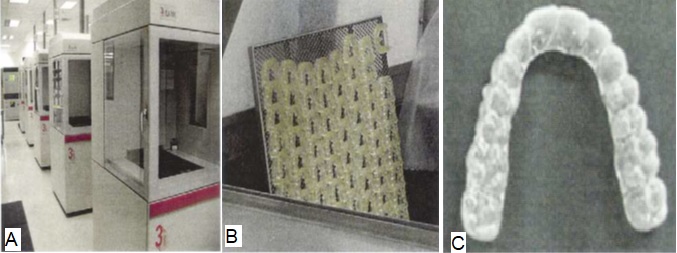
Working and Biomechanics
Controlling the position of roots and ensuring stable anchorage poses a significant challenge for orthodontists. The pivotal question arises: Can Invisalign serve as a viable alternative to traditional fixed appliances? Numerous studies have dwelled into the outcomes of Invisalign treatment, offering varied perspectives. Patel et al. observed a noteworthy enhancement in the PAR index among patients undergoing Invisalign treatment. Vincent [7] reported positive advancements in the ABO objective grading system concerning tooth alignment, though not as prominently in posterior occlusal contacts. On the other hand, Djeu et al [12] conducted a comparative analysis between Invisalign and fixed appliances, discovering that the ABO objective grading system (OGS) scores exhibited greater improvement in the fixed appliance group compared to the aligner group. In contrast, Brown et al. [9] asserted that, overall, Invisalign proved to be more effective than fixed appliances in achieving outcomes as defined by the OGS. The discussion thus underscores the varying findings regarding the efficacy of Invisalign compared to traditional fixed appliances in orthodontic treatment.
Simple versus Difficult Tooth Movements
In the context of a typical fixed appliance, a wire engages with a bracket, and adhesive secures the bracket onto the tooth. The active arch wire undergoes elastic deformation, guiding the tooth to a predetermined position as it returns to its original shape. In contrast, aligners employ plastic that encapsulates the tooth, serving the dual purpose of retention and activation to facilitate tooth movement. The natural undercuts of the teeth generally contribute to retention, while the elastic deformation of the aligner provides the active force for moving teeth.
This distinction is crucial for two primary reasons. First, the elastic deformation of the aligner must not be so substantial that it surpasses the retention forces. Second, certain directions exhibit a greater inherent ability of the aligner to undergo elastic deformation. It is worth noting that these discussions are based on the proprietary plastic used for aligners, known as Exceed 30 (Align Technology, Inc.), which is a 0.030 inch (0.76 mm)-thick thermoforming plastic. While ongoing research explores the use of dual-layer and other materials to impart aligners with different biomechanical properties, such materials are not the focus of this discussion. [13]
Force Levels in Aligners
Optimal forces for orthodontic movement adapted from profit ([Table 1]).[14]
|
Force (g) |
1986 |
2000 |
|
Tipping |
50 to 75 |
35 to 60 |
|
Bodily movement (translation) |
100 to 150 |
70 to 120 |
|
Root up righting |
75 to 125 |
50 to 100 |
|
Rotation |
50 to 100 |
35 to 60 |
|
Extrusion |
50 to 100 |
35 to 60 |
|
Intrusion |
15 to 25 |
10 to 20 |
As observed in the preceding two decades, there has been a consistent decrease in the perceived levels of force deemed necessary for various orthodontic movements. Following this trend, recent studies propose that, over time, forces as minimal as 18 grams may be adequate to induce bodily movement.[15] The overarching objective is to manage the position of the roots during orthodontic adjustments, aiming to attain the desired outcomes with minimal procedural complexity. This shift towards lower force requirements signifies a focus on optimizing treatment effectiveness while minimizing the potential for complications.
Attachments, Power Ridges and Auxiliaries
Addressing aligner displacement involves a strategic approach to the design and placement of attachments. These attachments serve a dual purpose: retaining the aligner and facilitating specific tooth movements. [Figure 6] illustrates the utilization of attachments for these purposes. [16]

The key lies in creating a ledge for the aligner to grip, positioned perpendicular to the direction of displacement. This ledge should be of sufficient size to offer ample surface area, effectively countering the applied force. Another straightforward guideline is to place the attachment at a distance from the gingival margin that prevents the aligner from spreading, stretching, and slipping off the attachment.
This concept is crucial because aligners tend to "relax" over time, exerting less force. As a result, a clinically observed side effect is a reduction in the retentiveness of the gingival third. It is worth noting that this observation contrasts with the findings of Jones et al., [17] which were based on laboratory results involving in-office–fabricated aligners whose properties remained unaffected by the oral environment.
Attachments have evolved to become custom-designed for precise movements on specific teeth tailored to each individual patient, marking a significant shift toward truly patient-specific treatment. Beyond directing forces in specific orientations, the amount of force is now controlled through the pre-activation of the aligner-attachment interface.
Innovations by Invisalign include smart force attachments, which optimize various movements, such as rotation, extrusion, root control, deep bite correction, and anchorage ([Figure 7]). Unlike, conventional passive attachments that enhance aligner engagement, these attachments play a more active role in guiding tooth movements. For instance, optimized root control attachments are crafted for upper central incisors and lower canines, managing root movement, tipping, and 'en masse' translation.
Additionally, optimized multi-plane attachments cater to molars requiring correction in both rotation and vertical positioning (intrusion or extrusion) simultaneously. Support attachments are designed to provide stability for predictable dental arch expansion. Notably, precision ramps dynamically adapt to tooth movement with each aligner, distinguishing them from braces, which can only be adjusted during in-office visits [18], representing a notable advantage.
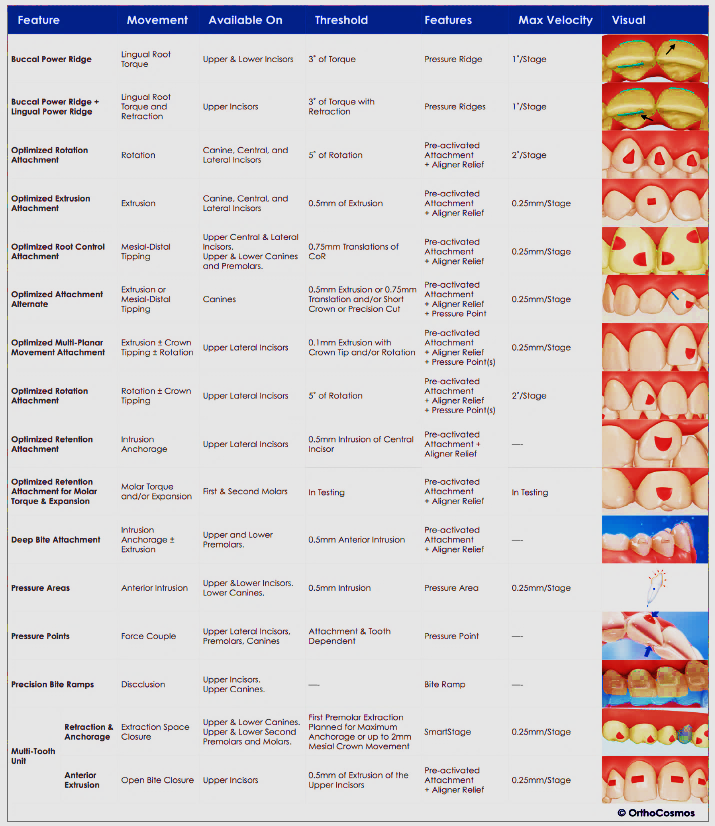
The versatile beveled attachment can be employed in various orientations by instructing the technician to rotate it differently. The notion suggests that specific rotations of the bevel may enhance particular movements ([Figure 8]A & B).

Correcting rotations with aligners presents challenges for two primary reasons. Firstly, aligners induce tooth movement by slightly distorting the plastic and then elastically rebounding it to the predetermined shape, carrying the tooth along. In the case of rotations, aligners struggle to undergo the necessary distortion for significant rotational movement. An analogy would be attempting to rotate a tooth with a large steel arch wire. Some propose using beveled attachments with the bevel turned 90 degrees (mesiodistally; [Figure 8]C) as a potential solution.
Attachments can be strategically placed anywhere to improve retention or movement. An alternative to attachments for facilitating torque control is the power ridge ([Figure 9]). Power ridges are designed corrugations placed at specific locations to enhance the undercut near the gingival margin of teeth undergoing torquing movements. These ridges serve two functions: stiffening the gingival third of the aligner for increased resilience and providing additional force close to the gingival margin to augment the effective moment arm of the aligner. The evident advantage of power ridges is that they eliminate the need for attaching or detaching, and they are more aesthetically pleasing to patients.
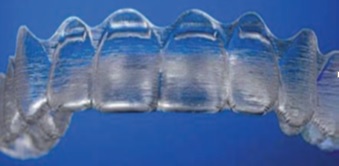
In the context of orthodontic treatment with clear aligners, the term auxiliaries refers to entities or items that can be utilized alongside clear aligners to improve the movement of teeth or bring about changes in dental or skeletal components [19]. Essentially, auxiliaries serve as complementary tools or interventions that work in conjunction with clear aligners to enhance the overall effectiveness of orthodontic treatment.
Some of the more common auxiliaries used in clear aligner treatment are ([Figure 10])
Bonded brackets or buttons with elastics for:
Bite closure (open anterior bites, open posterior bites)
Extrusion
Rotations
Class II and III Corrections
Limited braces:
Closing anterior and posterior open bites
Pre-aligner treatment in the late mixed dentition
Dimples made with pliers for:
Improving retention of the aligner
“Nudging” a tooth (rotations, tipping, torqueing)
Pontics when teeth are missing for:
Esthetics
To maintain space pre-restoration
Class II correctors and Molar distalizers:
Temporary anchorage device (TADs)
Where a movement is not being achieved as desired or planned with the aligner alone, auxiliaries can help to affect the desired movement.

Conclusion
The growing emphasis on appearance in personal and professional spheres has fueled a notable interest among adults in pursuing aligner therapy in recent years. The transparent nature of aligners enhances their aesthetic appeal, particularly for individuals hesitant to wear traditional fixed appliances.
The evolution of clear aligner treatment has been substantial since its inception. Invisalign's continual innovations, grounded in fundamental biomechanics, biomaterials, and orthodontic knowledge, have empowered practitioners to successfully address highly complex cases, yielding positive clinical outcomes.
Effectively educating patients about the advantages and disadvantages of clear aligner therapy relies significantly on understanding each patient's expectations and compliance. Initially, orthodontists must engage in clear communication with patients, thoroughly exploring conventional braces as an option. If patients opt for clear aligner therapy, they must grasp the importance of their compliance, responsibility, and the need to wear aligners for a substantial portion of the day—typically 20–22 hours.
One notable benefit of this therapy is the opportunity for patients to witness the progression of tooth movement and visualize the end result throughout various stages. Conversely, attempting to straighten one's own teeth through companies offering DIY orthodontic treatment is deemed unethical and poses risks to oral health. The absence of professional guidance and proper diagnosis in personalized treatment plans can lead to complications, including damage and jaw problems. Professional orthodontic care ensures a safe and effective treatment process.
Attempting to straighten your own teeth with companies providing DIY (Do It Yourself) orthodontic treatment is not an ethical practice and has a risk to one’s oral health. There is an absence of professional guidance and proper diagnosis. The personalized treatment plan can lead to complications that lead to damage and jaw problems. Professional orthodontic care ensures safe and effective treatment.
With technology incorporating "orthodontic smartness" into Invisalign aligners and continuously refining protocols and tools for treatment planning, aligner therapy is advancing towards becoming a true state-of-the-art treatment option.
Source of Funding
None
Conflict of Interest
None
References
- HD Kesling. The philosophy of tooth positioning appliance. Am J Orthod Oral Sur 1945. [Google Scholar]
- RJ Ponitz. Invisible retainers.. Am J Orthod 1971. [Google Scholar]
- MR Sims. Brackets, epitopes and flash memory cards: a futuristic view of clinical orthodontics. AustOrthod J 1999. [Google Scholar]
- ML Jones, J Mah, BJ O'Toole. Retention of thermoformed aligners with attachments of various shapes and positions. J ClinOrthod 2009. [Google Scholar]
- X Phan, PH Ling. Clinical limitations of Invisalign. J Can Dent Assoc 2007. [Google Scholar]
- D Paquette, OC Tuncay. Extraction treatment with Invisalign. The Invisalign System 2006. [Google Scholar]
- R Boyd. Improving periodontal health through Invisalign treatment. Access 2005. [Google Scholar]
- RL Boyd. Esthetic orthodontic treatment using the invisalign appliance for moderate to complex malocclusions. J Dent Educ 2008. [Google Scholar]
- RL Boyd. Complex orthodontic treatment using a new protocol for the Invisalign appliance. J Clin Orthod 2007. [Google Scholar]
- G Djeu, C Shelton, A Maganzini. Outcome assessment of Invisalign and traditional orthodontic treatment compared with the American Board of Orthodontics objective grading system. Am J Orthod Dento facial Orthop 2005. [Google Scholar]
- P Brown, B Bayirli, B Gaynier, D Vazquez. Comparison Of Invisalign To Fixed Orthodontic Treatment Using ABO Indices. 2007. [Google Scholar]
- P Owman-Moll, J Kurol, D Lundgren. Effects of four-fold increased orthodontic force magnitude on tooth movement and root resorption. An intra-individual study in adolescents.. Eur J Orthod 1996. [Google Scholar]
- WR Proffit, WR Proffit. Mechanical principles in orthodontic force control. Contemporary orthodontics 1986. [Google Scholar]
- LR Iwasaki, JE Haack, JC Nickel, J Morton. Human tooth movement in response to continuous stress of low magnitude. Am J Orthod Dento facial Orthop 2000. [Google Scholar]
- MJ Chang, CH Chen, CY Chang, Joshua, CH Chang, WE Roberts. Introduction to Invisalign® Smart Technology: Attachments Design, and Recall-Checks. J Digital Orthod 2019. [Google Scholar]
- A Becker, S Chaushu. Long-term follow-up of severely resorbed maxillary incisors after resolution of an etiologically associated impacted canine. Am J Orthod Dentofacial Orthop 2005. [Google Scholar]
- ML Jones, J Mah, BJ O'Toole. Retention of thermoformed aligners with attachments of various shapes and positions. J Clin Orthod 2009. [Google Scholar]
- O Malmgren, L Goldson, C Hill, A Orwin, L Petrini, M Lundberg. Root resorption after orthodontic treatment of traumatized teeth. Am J Orthod 1982. [Google Scholar]
- I Brin, Y Ben-Bassat, I Heling, A Engelberg. The influence of orthodontic treatment on previously traumatized permanent incisors. Eur J Orthod 1991. [Google Scholar]
- Introduction
- Selection Criteria
- Advantages [4]
- Limitations [5]
- Impression Technique and Digitization
- Records — Submission
- The Virtual Setup
- Software
- Fabrication of Appliances
- Working and Biomechanics
- Simple versus Difficult Tooth Movements
- Force Levels in Aligners
- Attachments, Power Ridges and Auxiliaries
- Conclusion
- Source of Funding
- Conflict of Interest
